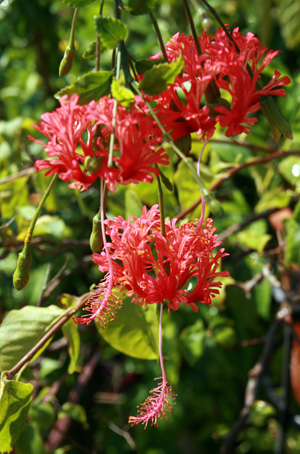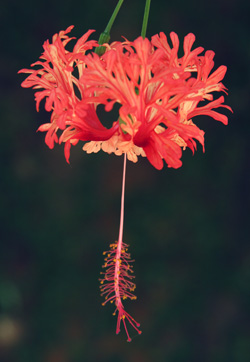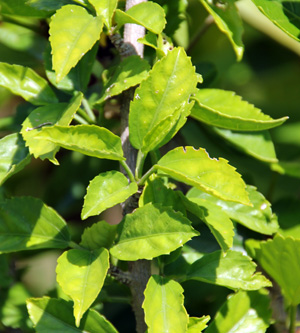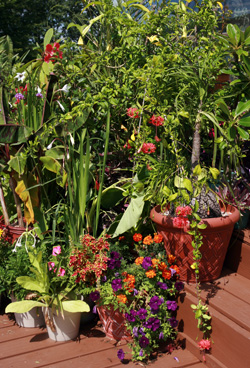
Tropical hibiscus can add a colorful splash to container plantings or as indoor flowering plants. The most commonly offered types are selections or hybrids of Hibiscus rosa-sinensis (Chinese hibiscus) that have the typical flowers with large petals and a prominent central staminal column. But there is another much less common species that has been used in hybridizing some of the garden cultivars (for example, Hibiscus x archerii) that is also well worth growing. Hibiscus schizopetalus, with various common names including Coral Hibiscus, Fringed Hibiscus, Skeleton Hibiscus, Chinese Lantern, Japanese Lantern, and Pagoda Flower, is a native of tropical East Africa (Kenya, Tanzania, and Mozambique) with unusual, lacy flowers. Instead of upward or outward-facing flowers, this species has pendant flowers that dangle from slim, arching stems. In the tropics this evergreen perennial is used in ornamental borders and for hedges. In temperate areas it tends to be a curiosity in botanic gardens and specialty nurseries but can be grown as a houseplant or seasonal annual.

The delicate flowers are a bright red color or streaked red and pink, with 2½ inch long petals that are deeply pinnately-lobed, cut and fringed. The 5 petals are reflexed, curving back to form a sphere shape. They hang from the stems on long, thin pedicels up to 6 inches long with the staminal columns dangling below. Each column is longer than the corolla (up to 4 inches long) with a 5-branched style and anthers near the upward-curving tip.

The distinctive flowers with their frilly petals and long slender column are variously described as looking like an oriental lantern, a parachute or a chandelier. The flowers are produced singly from leaf axils on upper stems. Plants will bloom intermittently throughout the year if they have sufficient light. If pollinated, flowers may be followed by oblong seed capsules.

The foliage of this species resembles most other types of hibiscus, although the leaves are often smaller, more narrow, and a lighter green color than many of the H. rosa-sinensis cultivars. The alternate leaves are hairless and sharply toothed but unlobed, and elliptic to oblong in shape. Each leaf is borne on a short petiole. The plant is a rangy shrub growing 10-12 feet tall and equally wide if not pruned, resembling a weeping tree more than a typical shrub. The growth habit is rather leggy, with long, slender and flexible, gracefully arching woody branches up to 10 feet. It is a rapid grower and will easily achieve several feet of growth in a single season.
This species is typically grown as a container plant in the Midwest, although it could be planted in the ground during the warm summer months. It is occasionally used as an annual in hanging baskets. As a tropical plant, it does best under warm conditions should be protected whenever temperatures approach freezing. Container plants should be moved indoors before nighttime temperatures are in the high 30’s. Although the plant may survive a light freeze, it will lose all its leaves.

H. schizopetalus prefers full sun and copious moisture. As a houseplant it should be given as much light as possible. Unless it can be kept in a greenhouse or sunroom during the winter, it will require acclimatization when moved outdoors for the summer or the leaves will sunburn and drop off. Container-grown plants will require daily watering during the warm summer months but need much less when indoors with less light and cooler temperatures. Repot in early spring every few years to maintain vigor.
This plant is easy to grow in rich potting medium and is cultivated just like for Chinese hibiscus. However, unlike Chinese hibiscus which benefits from pruning to increase compactness and to promote flowering, H. shizopetalus plants bloom better if left unpruned, as the flowers are produced on short spurs from the previous year’s wood. So pruning should be done sparingly – every 3-4 years to maintain vigor. Cutting back annually will limit or eliminate blossoming. This is actually more of a challenge than it might seem, as the plant grows very long stems so it does not fit well into many indoor locations. Fertilization does not improve blooming like with Chinese hibiscus. It is susceptible to the same pests that plague Chinese hibiscus, including aphids, mealybugs, spider mites, and whiteflies.
This species is easily propagated from semi-hardwood cuttings in spring or by layering. Cuttings root best when treated with rooting hormone and kept in humid conditions.
– Susan Mahr, University of Wisconsin – Madison
Latest from Wisconsin Yard & Garden
Ask Your Gardening Question
If you’re unable to find the information you need, please submit your gardening question here:





 Marigolds
Marigolds Create a Butterfly Garden
Create a Butterfly Garden Plant Flowers to Encourage Beneficial Insects
Plant Flowers to Encourage Beneficial Insects Forcing Bulbs
Forcing Bulbs


